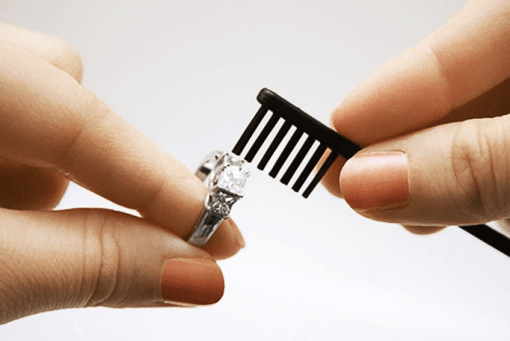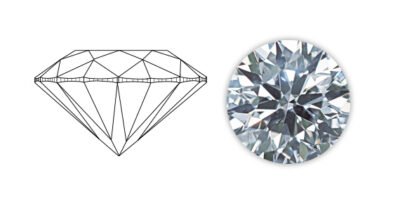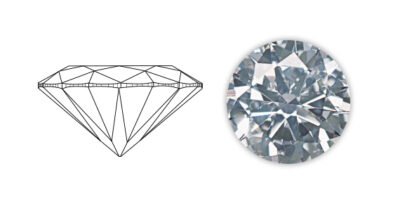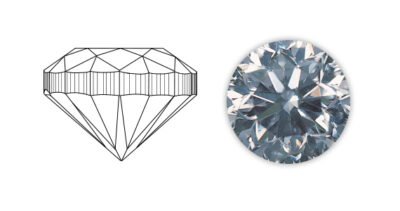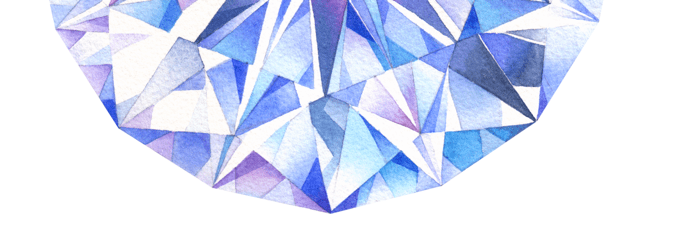
Diamond Buying Guide
We know you’re here because you only want the best and we would love to help you find the perfect diamond for you. We also know that buying diamonds can be a little overwhelming, but that doesn’t mean that you should ever settle or stress! So just sit back with a cup of coffee and let us walk you through everything you need to know before you buy that sparking diamond!
Back to the Basics - The 4 Cs of a Diamond
1. Cut:
We believe the cut is the most important aspect of choosing a diamond. It’s basically what determines the proportion, symmetry and polish of a diamond. The right cut will enhance the sparke and the scintillation of the diamond. The better the cut, the more likely your diamond is to sparkle bright and look gorgeous!
Goldhartz Hint:
Invest in the cut. It’s the ultimate diamond hack (you’ll not find it in the books). A beautifully cut diamond can make the color and clarity appear better than they are.
2. Clarity
When light passes through a diamond, it bounces back, making the diamond sparkle! Some diamonds have imperfections in the form of spots and blemishes. The more the imperfections, the more difficult it is for light to pass through, thereby reducing the sparkle. If you’re lost, here’s all you need to remember: Lesser imperfection and inclusions = Better clarity
Goldhartz Hint:
If you’re buying a diamond that’s under a carat, don’t obsess over the spots or blemishes because they aren’t really visible to an untrained eye. It’s better to invest in the cut and sparkle on!

FL – Flawless Flawless diamonds have no inclusions or blemishes detectable under 10x magnification, and are extremely rare.
IF – Internally Flawless Internally Flawless diamonds have no inclusions and only blemishes are visible to a skilled grader using 10x magnification.
VVS1/VVS2 – Very, Very Slightly Included Very, Very Slightly Included diamonds have minute inclusions that range from extremely difficult to very difficult to see are visible to a skilled grader using 10x magnification.
VS1/VS2 – Very Slightly Included Very Slightly Included diamonds have minor inclusions that range from difficult to somewhat easy to see are visible to a skilled grader using 10x magnification.
S1/S2 – Slightly Included Slightly Included diamonds have noticeable inclusions that range from easy to very easy to see are visible to a skilled grader using 10x magnification.
I1/I2/I3 – Included Included diamonds have obvious inclusions that are visible to a skilled grader using 10x magnification and may affect transparency and brilliance.
Goldhartz Recomended Cut - Good
3. Colour
Ironically, the best color for a diamond would be ‘colorless’. The colors range from D (colorless) and go all the way to Z (light yellow). To be honest, the colour difference in diamonds within a colour family is quite subtle to an untrained eye. Nevertheless, they do create a difference in the price and quality of the diamond. Bottom line is, colorless diamonds are the most precious!
Goldhartz Hint:
As diamond size increases, colour becomes more noticeable. This is especially important to keep in mind if you are purchasing a diamond of two carats or greater. If you pick a slightly yellow colored diamond, you can pair it with a white gold or platinum band. The white gold will complement the yellow hue of your diamond, and they won’t clash with each other!
4. Carat
Ironically, the best color for a diamond would be ‘colorless’. The colors range from D (colorless) and go all the way to Z (light yellow). To be honest, the colour difference in diamonds within a colour family is quite subtle to an untrained eye. Nevertheless, they do create a difference in the price and quality of the diamond. Bottom line is, colorless diamonds are the most precious!
Goldhartz Hint:
As diamond size increases, colour becomes more noticeable. This is especially important to keep in mind if you are purchasing a diamond of two carats or greater. If you pick a slightly yellow colored diamond, you can pair it with a white gold or platinum band. The white gold will complement the yellow hue of your diamond, and they won’t clash with each other!

Shop by Diamond Shapes

Shape
Shape refers to the overall outline of the diamond when viewed from the top and that determines the price as well. The most expensive shape is the round diamond. That’s because they are best at reflecting light and shine like there’s no tomorrow! Although the choice of the shape mostly depends on your personal style, a princess, cushion or heart cut is what we would recommend if your diamond is bigger than 1 carat.
Diamond Grading
- Say Hello to Halo! It makes the centre stone look bigger and works as a protective shield as well Go fancy with cushion and emerald cuts.
- They’re usually priced lower and make ‘em eyes pop, too!
- Pick a diamond with an ‘excellent’ or ‘ideal’ cut and nothing less than that Although the round is the most expensive cut, it hides the imperfections and the yellowish colour in the best way. It’s like a realllly good concealer 😉
Certifications
The Certification is basically your diamond’s birth certificate. All our solitaire diamonds are meticulously analyzed and graded by the Gemological Institute of America (GIA), Hoge Raadvoor Diamant (HRD) & the IGI, the most trusted (and known) labs in the world.
